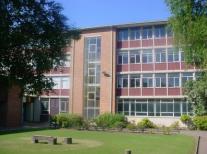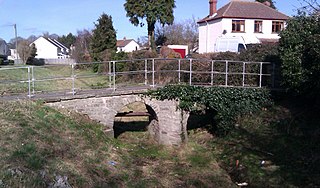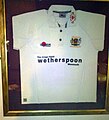
Monmouth is a town and community in Wales. It is situated where the River Monnow joins the River Wye, 2 miles (3.2 km) from the Wales–England border. Monmouth is 30 miles (48 km) northeast of Cardiff, and 113 miles (182 km) west of London. It is within the Monmouthshire local authority, and the parliamentary constituency of Monmouth. The population in the 2011 census was 10,508, rising from 8,877 in 2001. Monmouth is the historic county town of Monmouthshire although Abergavenny is now the county town.

Monmouth School for Boys is a public school for boys in Monmouth, Wales. The school was founded in 1614 with a bequest from William Jones, a successful merchant and trader. The School is run as a trust, the William Jones's Schools Foundation, by the Worshipful Company of Haberdashers, one of the livery companies, and has close links to its sister school, Haberdashers' Monmouth School for Girls. In 2018, the Haberdashers renamed their group of schools in the town, the Monmouth Schools, and made corresponding changes to the names of the boys' and girls' schools.

Croesyceiliog is a suburb of Cwmbran, Wales.
1864 was the 78th season of cricket in England. It was a significant year in cricket history, as it saw the legalisation of overarm bowling and the first edition of John Wisden's Cricketers' Almanac.

Monmouth Town Football Club is a Welsh football club based in the historic town of Monmouth. The club plays in the Ardal Leagues South East, tier 3 of the Welsh football pyramid.
Monmouth Rugby Football Club is a rugby union club, from Monmouth in South Wales. The club is a member of the Welsh Rugby Union and is a feeder club for the Newport Gwent Dragons.

The Shire Hall in Agincourt Square, Monmouth, Wales, is a prominent Grade I listed building in the town centre. It was built in 1724, and was formerly the centre for the Assize Courts and Quarter Sessions for Monmouthshire. In 1839–40, the court was the location of the trial of the Chartist leader John Frost and others for high treason for their part in the Newport Rising. The building was also used as a market place. The Shire Hall is owned by Monmouthshire County Council and has audiovisual guides for visitors to Courtroom 1. It is currently used as a Tourist Information Centre and as the offices for Monmouth Town Council, and is open to the public in part.
John Robert Tait was a Scottish cricketer who played in English and Welsh leagues. A right-hand bat and occasional right-arm off break bowler, Tait played forty four first class cricket matches for Glamorgan between 1921 and 1926, having played minor county cricket for the club since 1911. He played in Glamorgan's inaugural County Championship match in 1921 and was dismissed for 96, four runs from being the county's first centurion. In his entire career, he scored 1,477 runs at 18.23 including seven half-centuries.

Drybridge House is a large 17th-century Grade II* listed building in Monmouth, south east Wales. It is located to the southwest of the town at one end of Drybridge Street, close to the “dry bridge” over a small stream, which is now buried beneath a nearby roundabout. It is one of 24 buildings on the Monmouth Heritage Trail, and is now managed as the Bridges Centre.

St Mary's Priory Church, in Whitecross Street, Monmouth, Monmouthshire, Wales, is an Anglican church founded as a Benedictine priory in 1075. The current church dates mostly from the 18th and 19th centuries. It was designated a Grade II* listed building in 1952. It is one of 24 buildings on the Monmouth Heritage Trail.

Agincourt House, No. 1 Agincourt Square, Monmouth, Monmouthshire, Wales is a notable early seventeenth century half-timbered building.

Overmonnow is a suburb of the town of Monmouth, in Wales, which is located to the west of the River Monnow and the Monnow Bridge. It developed in the Middle Ages, when it was protected by a defensive ditch, the Clawdd-du or "Black Dyke", the remains of which are now protected as an ancient monument. In later centuries the area became known as "Little Monmouth" or "Cappers' Town".

The Cross is situated in St Thomas' Square, Overmonnow, Monmouth, Wales, in the middle of a roundabout opposite the Church of St Thomas the Martyr and the western end of the Monnow Bridge. Originally mediaeval, and also known as Overmonnow Cross, the cross was reconstructed in 1888 and has been classed as a Grade II listed structure since 15 August 1974.
Charles Henry Crompton-Roberts was a British landowner and politician. He was briefly a Member of Parliament before his election was annulled in 1880, and was a substantial contributor to the amenities and community of Monmouth in Wales.

Vauxhall Fields, also known as Vauxhall Meadows, are water meadows to the northwest of Monmouth town centre, Wales. The River Monnow borders the meadows on two sides. The meadows have generally remained free of development. The area has been prone to flooding on many occasions over the years.

Chippenham Mead is a town green in Monmouth, Wales. The mead is registered common land and stands between Blestium Street and the River Wye, intersected by the A40(T) Monmouth bypass. There is a sports area within the park called Chippenham Sports Ground. The mead is listed at Grade II on the Cadw/ICOMOS Register of Parks and Gardens of Special Historic Interest in Wales.

The Clawdd-du, also known in historical records as the Black Dyke, Black Ditch or Clawthy, is a mediaeval linear defensive earthwork or moat, constructed as protection for the faubourg of Overmonnow, on the opposite side of the River Monnow from the town and castle of Monmouth, Wales.
There are a number of war memorials in Monmouth, Wales.

Glendower Street is a historic street in the town centre of Monmouth, Monmouthshire, Wales. It extends to the southeast from the intersection of Agincourt Street and St John's Street, within the medieval town walls. Glendower Street is lined with numerous listed buildings, including one of the 24 blue plaque buildings on the Monmouth Heritage Trail.

The Monmouth Police Station is a Grade II listed building in the town centre of Monmouth, Monmouthshire, Wales. It is located in Glendower Street, within the medieval town walls. In March 2012, it was announced that the Monmouth Police Station was one of seventeen police stations in South East Wales that would no longer be open to the public.


















